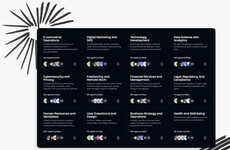
Jeremy Gutsche — March 16, 2006 — About
References: jscms.jrn.columbia.edu
Trend Hunter was featured in a recent article from Columbia News. Check it out:
Moving online: the new trend in trend spotting
By Nichola Saminather
Green is the new black, and the latest product to cash in on the environmental boom is denim jeans, which are now made of hemp and sugarcane, says treehugger.com, a Web site that follows environmental trends around the world.
Wireless networks and comfy chairs are expanding the decade-old trend of “being-spacesâ€--where people come to spend hours reading or working--into supermarkets, airports and even hospitals, according to trendwatching.com, a site that tracks consumer trends across the planet.
And Mercedes-Benz plans to launch an “intelligent bike†with an automatic gearshift system, reports PSFK.com, a Web site that reports individual developments that contribute to larger trends.
These sites are manifestations of the latest in trend spotting--the creation of an open and constantly available source of information about developments in business, fashion, lifestyle and just about every other aspect of life. Just as many trends evolve as they are affected by newer trends, so these sites are responses to demands for transparency and consumer participation spurred by today's information revolution.
But in this age when what was new yesterday is old tomorrow, what makes a trend? Netherlands-based trendwatching.com offers a definition: “A trend is a manifestation of something that has newly serviced an existing (and hardly ever changing) consumer need, desire, want or value.†An example is the Internet, which is growing in response to humans' need for knowledge.
What about the current hot color, fabric or designer label? And what is expected in 15 to 20 years? These do not a trend make, says trendwatching.com. The former are fads, the latter, predictions. Also not included is “cool hunting,†which involves discovering individual occurrences that are unique and interesting, but don't contribute to an overarching trend.
Sticking to trend spotting under this definition prevents mistakes, said Renier Evers, creator of trendwatching.com, in an e-mail interview. “We don't forecast, we describe, so no mishaps,†he said. “We add our own thinking and insights and illustrate with real world examples companies already capitalizing on those trends and developments.â€
To ensure that these examples are reliable, trendwatching.com has five full-time employees with economics and marketing backgrounds who research the latest thinking from psychologists, sociologists, economists and business thinkers, and draw larger conclusions from the 8,000-plus contributions the site receives.
Trendhunter.com, a Canadian magazine that began in January, also relies on a similar, albeit smaller, global network of 15 regulars. Contributors are required to include the source of their stories, so the editor in chief, Jeremy Gutsche, and two senior editors can verify the information.
Michael Tchong, founder of ubercool.com, however, uses contributors sparingly, preferring to track “ubertrends,†large trends that drive smaller ones, mostly on his own.
So far, Tchong has identified seven ubertrends: “fountain of youth,†the desire to put off ageing for as long as possible; “time compression,†where life is faster than ever; “generation X-tasy,†the normalization of vices like gambling, X-rated fare and drug use; “unwired,†the proliferation of wireless technology; “voyeurgasm,†the growth of real-time viewing, which has resulted in phenomena like camera phones and reality television; “digital technology,†possibly the ubertrend of ubertrends; and the “woman acceptance factor,†which points to the growing role of women in today's society.
One contributor to Ubercool is Jinal Shah, a freelance writer who also supplies information to PSFK. Shah, who has her own fashion blog at stylestation.typepad.com, started contributing because her innate curiosity enabled her to spot the connection between isolated incidents that make up a trend.
“Our generation, we're creators,†said Shah, 23. “We know what we want. We don't need to be told to try something, we learn for ourselves.â€
Being a part of this generation, which is driving most of the current trends, makes her a resource for such sites.
What makes sites like the ones Shah contributes to different is that they are so open with their information. Piers Fawkes, the P and F of PSFK.com, explained: “We're different from the old school, where they gather information, have their secrets and sell that knowledge.â€
Among the trend spotters in the “old school†is Faith Popcorn, who has been the mainstay of the trend analysis industry for more than a decade. Popcorn, author of the best-selling “Popcorn Report,†has a Web site, but the only information it reveals is her contact details.
Sites like PSFK, Trend Hunter and trendwatching.com are accessible to anyone, both readers and contributors, and contain immense amounts of information. PSFK even links to other trend-spotting sites, and trendwatching.com offers free advice on how to be an effective trend spotter.
After all, Fawkes said, it is not the information itself, which PSFK gets from about 30 global contributors, that keeps PSFK solvent, but the advice it offers based on that data.
George Murphy, founder and chief executive of Modo Group, a consulting firm that offers branding and consumer insights to companies like Microsoft and Starbucks, said the social networks surrounding the blogging world, in which companies like PSFK exist, gives the information they unearth a “more gritty, street level†quality.
PSFK also reaches people in their own environments, in bars and at football games, rather than in more artificial settings like focus groups, which are the realm of traditional market researchers.
Tchong of Ubercool points to another reason that businesses turn to companies like his. “I move in many, many circles,†he said. “They move in only one. And I acquire a radically different perspective because my instincts have been honed over time.â€
Such honing, however, comes only with a constant thirst for knowledge and the ability to digest and analyze vast amounts of detail, gained through reading, writing, traveling and observing.
Gutsche sums it up: “I've always been insatiably curious and obsessed with innovation. Now I find myself trying to more deeply understand the social factors that push a new product or style into the mainstream. Part of my interest derives from the fact that I'm an entrepreneur at heart and I want to invent, market or design the next big thing.â€
Moving online: the new trend in trend spotting
By Nichola Saminather
Green is the new black, and the latest product to cash in on the environmental boom is denim jeans, which are now made of hemp and sugarcane, says treehugger.com, a Web site that follows environmental trends around the world.
Wireless networks and comfy chairs are expanding the decade-old trend of “being-spacesâ€--where people come to spend hours reading or working--into supermarkets, airports and even hospitals, according to trendwatching.com, a site that tracks consumer trends across the planet.
And Mercedes-Benz plans to launch an “intelligent bike†with an automatic gearshift system, reports PSFK.com, a Web site that reports individual developments that contribute to larger trends.
These sites are manifestations of the latest in trend spotting--the creation of an open and constantly available source of information about developments in business, fashion, lifestyle and just about every other aspect of life. Just as many trends evolve as they are affected by newer trends, so these sites are responses to demands for transparency and consumer participation spurred by today's information revolution.
But in this age when what was new yesterday is old tomorrow, what makes a trend? Netherlands-based trendwatching.com offers a definition: “A trend is a manifestation of something that has newly serviced an existing (and hardly ever changing) consumer need, desire, want or value.†An example is the Internet, which is growing in response to humans' need for knowledge.
What about the current hot color, fabric or designer label? And what is expected in 15 to 20 years? These do not a trend make, says trendwatching.com. The former are fads, the latter, predictions. Also not included is “cool hunting,†which involves discovering individual occurrences that are unique and interesting, but don't contribute to an overarching trend.
Sticking to trend spotting under this definition prevents mistakes, said Renier Evers, creator of trendwatching.com, in an e-mail interview. “We don't forecast, we describe, so no mishaps,†he said. “We add our own thinking and insights and illustrate with real world examples companies already capitalizing on those trends and developments.â€
To ensure that these examples are reliable, trendwatching.com has five full-time employees with economics and marketing backgrounds who research the latest thinking from psychologists, sociologists, economists and business thinkers, and draw larger conclusions from the 8,000-plus contributions the site receives.
Trendhunter.com, a Canadian magazine that began in January, also relies on a similar, albeit smaller, global network of 15 regulars. Contributors are required to include the source of their stories, so the editor in chief, Jeremy Gutsche, and two senior editors can verify the information.
Michael Tchong, founder of ubercool.com, however, uses contributors sparingly, preferring to track “ubertrends,†large trends that drive smaller ones, mostly on his own.
So far, Tchong has identified seven ubertrends: “fountain of youth,†the desire to put off ageing for as long as possible; “time compression,†where life is faster than ever; “generation X-tasy,†the normalization of vices like gambling, X-rated fare and drug use; “unwired,†the proliferation of wireless technology; “voyeurgasm,†the growth of real-time viewing, which has resulted in phenomena like camera phones and reality television; “digital technology,†possibly the ubertrend of ubertrends; and the “woman acceptance factor,†which points to the growing role of women in today's society.
One contributor to Ubercool is Jinal Shah, a freelance writer who also supplies information to PSFK. Shah, who has her own fashion blog at stylestation.typepad.com, started contributing because her innate curiosity enabled her to spot the connection between isolated incidents that make up a trend.
“Our generation, we're creators,†said Shah, 23. “We know what we want. We don't need to be told to try something, we learn for ourselves.â€
Being a part of this generation, which is driving most of the current trends, makes her a resource for such sites.
What makes sites like the ones Shah contributes to different is that they are so open with their information. Piers Fawkes, the P and F of PSFK.com, explained: “We're different from the old school, where they gather information, have their secrets and sell that knowledge.â€
Among the trend spotters in the “old school†is Faith Popcorn, who has been the mainstay of the trend analysis industry for more than a decade. Popcorn, author of the best-selling “Popcorn Report,†has a Web site, but the only information it reveals is her contact details.
Sites like PSFK, Trend Hunter and trendwatching.com are accessible to anyone, both readers and contributors, and contain immense amounts of information. PSFK even links to other trend-spotting sites, and trendwatching.com offers free advice on how to be an effective trend spotter.
After all, Fawkes said, it is not the information itself, which PSFK gets from about 30 global contributors, that keeps PSFK solvent, but the advice it offers based on that data.
George Murphy, founder and chief executive of Modo Group, a consulting firm that offers branding and consumer insights to companies like Microsoft and Starbucks, said the social networks surrounding the blogging world, in which companies like PSFK exist, gives the information they unearth a “more gritty, street level†quality.
PSFK also reaches people in their own environments, in bars and at football games, rather than in more artificial settings like focus groups, which are the realm of traditional market researchers.
Tchong of Ubercool points to another reason that businesses turn to companies like his. “I move in many, many circles,†he said. “They move in only one. And I acquire a radically different perspective because my instincts have been honed over time.â€
Such honing, however, comes only with a constant thirst for knowledge and the ability to digest and analyze vast amounts of detail, gained through reading, writing, traveling and observing.
Gutsche sums it up: “I've always been insatiably curious and obsessed with innovation. Now I find myself trying to more deeply understand the social factors that push a new product or style into the mainstream. Part of my interest derives from the fact that I'm an entrepreneur at heart and I want to invent, market or design the next big thing.â€
Trend Themes
1. Moving Online - Opportunity for businesses to leverage the growing trend of online trend spotting to stay informed and capitalize on emerging consumer needs.
2. Environmental Boom - Opportunity to tap into the trend of eco-friendly products, such as denim jeans made of hemp and sugarcane, to meet the increasing consumer demand for sustainable options.
3. Intelligent Bikes - Disruptive innovation opportunity for companies to develop and market intelligent bikes with automatic gearshift systems, catering to the growing interest in smart and connected transportation solutions.
Industry Implications
1. Fashion - Fashion industry can capitalize on the trend of eco-friendly products, such as denim jeans made of sustainable materials, to meet consumer demand for more sustainable fashion options.
2. Consumer Electronics - Tech companies can explore the market for intelligent bikes with automatic gearshift systems, offering consumers smart and connected transportation solutions for urban mobility.
3. Market Research - Growing trend of online trend spotting presents opportunities for market research companies to provide businesses with valuable insights and analysis on emerging consumer needs and trends.
6
Score
Popularity
Activity
Freshness






















